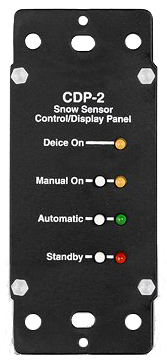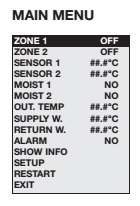Getting the Most out of Your Snowmelt System During Extreme Snow Events
Your Warmzone snow melting system was designed according to ASHRAE standards, meaning it was designed specifically for typical winter conditions in your area – and then some. But every now and then Mother Nature unleashes a furious “perfect storm” of epic proportions that overwhelm even the most hardy winter-weather cities. Snow plows, public transportation and basic city services can be brought to their knees because of unusually low temperatures and record breaking snowfall. Even fully automated radiant snow melting systems are faced with some unique challenges posed by the extreme conditions. Fortunately, Warmzone snowmelt systems include features that allow you to better cope with winter anomalies such as an extreme snow event.
Tips – Preparing for an Extreme Snow Event
If you’re faced with a potential storm of record magnitude, follow the steps outlined below.
Timer: If you purchased a timer with your heated driveway system, use this manual override feature to pre-heat your driveway 2-4 hours before the storm hits. (Once the snow starts to fall, the snow switch will detect precipitation and automatically activate the system.)
Aerial Mount Snow Switch: If you don’t have a timer, you can still manually activate the system using the WS-AUX controller or the aerial-mount snow switch. To activate the system using the snow switch, flip the toggle switch on the side of the unit up so that it is in the ON position. This activates the system and begins pre-heating the driveway. (NOTE: Remember that the system will remain on until you return the toggle switch to AUTOMATIC or STANDBY.)

WS-AUX Controller: Activating the system using the WS-AUX controller is the most convenient method for pre-heating your driveway or walks. Turning the sensor override switch on the WS-AUX to the MANUAL ON position will activate the snowmelt system continuously. Pressing the MANUAL ON button on the WS-AUX will not trigger the sensor to run continuously but will initiate one “drying cycle.” This mode can be used to test the system or clear any remaining un-melted snow. This function allows the user to run a cycle without having to remember to turn the system back off. The sensor will initiate one drying cycle and revert to automatic mode, thereby making it ready for detection of the next storm. The MANUAL ON mode can be activated directly from either AUTOMATIC or STANDBY mode. The user may reset and clear the drying cycle by pressing STANDBY.
The WS-AUX will show the current setting of the manual override switch for the attached snow sensor. The sensor’s override switch will always take precedence over the WS-AUX setting. If, for example, the WS-AUX has placed the sensor into STANDBY mode and the sensor switch is moved to MANUAL ON, the WS-AUX will show a change to MANUAL ON mode. Whenever the sensor’s switch overrides the WS-AUX’s setting, then returns to AUTOMATIC mode, the WS-AUX will also revert to AUTOMATIC mode.
In-Ground Snow Switch: For those utilizing the pavement-mount snow switch, refer to page 6 and 9 of the ETO2 User’s Guide Programming Manual.
Working with the Controller
Pre-heat Your Driveways in Preparation for Record Snowfalls

In MAIN MENU of the controller, turn the dial to scroll down to SETUP (as seen on page 6 of the User Manual). After selecting SETUP, scroll down to FORCE HEAT and push the dial in to select. This will then activate the system.
Naturally, you do not want to turn the snow melting system on too late or too early, so follow the local weather reports and make your best guess as to when the storm’s first snow will fall. It is recommended to begin pre-heating your driveway (or sidewalks) 2 to 4 hours before any excessively large storm hits. This gives your system a “head start” that will help it to keep up with the unusually heavy snowfall.
Remember, pre-heating the driveway is not necessary in most other cases. Your automated snow melting system was designed to effectively handle typical winter storms in your area. The steps outlined here are simply offered as suggestions to help you cope with the occasional record-breaking snow storm.
 The heat will stay on the amount of time the designated in the AFTERRUN mode. Once the FORCE HEAT cycle is complete, the device will default back to AUTOMATIC mode. The falling snow will then keep the system on.
The heat will stay on the amount of time the designated in the AFTERRUN mode. Once the FORCE HEAT cycle is complete, the device will default back to AUTOMATIC mode. The falling snow will then keep the system on.

Adjusting the AFTERRUNTo adjust the AFTERRUN, remain in the SETUP menu.
Refer to page 10 of the User’s Manual.
Set the time for how long before the snowfall that you want to pre-heat the driveway area. Typical time ranges between 2 and 4 hours, depending on the storm.)
Check out Warmzone’s helpful instructional videos on YouTube:
Video instructions on tuning your pavement mount controller
Video instructions for programming your WS-5C aerial-mount snow sensor
Remember, a snow melting system is only as good as it’s installation. So if you’re considering purchasing a radiant heat system, be sure to deal only with experienced professionals who legitimately offer a dedicated support team that will work with you and guide you through the installation process.
And when those record breaking storms come calling at your doorstep, be sure to get the most out of your ClearZone snow melting system by talking to the pros at Warmzone. If you have any questions, feel free to pick up the phone and call Warmzone for additional radiant heat information or to learn how to best deal with extreme snow events. Our business is built on customer service, and we take great pride in being responsive to our customers needs, so don’t hesitate to contact an experienced radiant heat professional at Warmzone today (888.488.9276).
